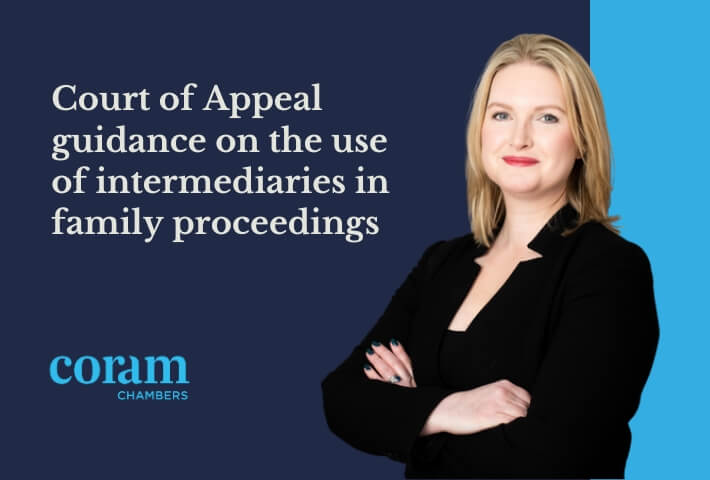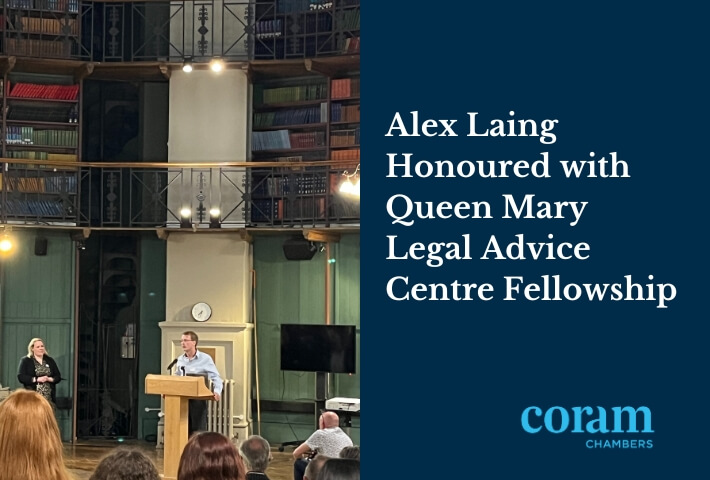Roger McCarthy KC, former Head of Chambers provides a view on the case of Williams v Williams [2024] EWHC 733 (Fam)
Legal representative (LR) | Williams v Williams (the current case)
Williams v Williams [2024] EWHC 733 (Fam)
Online applications for decree absolute are expected to be both speedy and straightforward. In the current case the application was filed at 5.13pm and the order issued at 5.45pm on the same day.
It is difficult to imagine that this case would attract national media attention or raise any difficult points of law. Yet this is just what has happened in relation to the recent judgment of the President of the Family Division in Williams v Williams [2024] EWHC 733 (Fam) (handed down on 10.4.24).
As the well-known familiar law says “what can go wrong, will go wrong”. The “what” in the current case was a speedy procedure with little more court scrutiny than a rubber stamp.
Nevertheless the judgment itself was a model of judicial description and analysis and all of the arguments and conclusions are very clear.
This article does not analyse the details of the judgment. It does refer to topics which were neither raised before, nor analysed by, the President. The aim is to identify the topics which could in conjunction with the same facts (and an additional one that could have been picked up) have led to a different conclusion.
The remarkable facts were summarised in the first two paragraphs of the judgment:-
1.“On the 3rd October the online divorce protocol operated by HM Courts and Tribunals Service [“HMCTS”] issued a final order of divorce in proceedings between Mrs Wiliams, the applicant wife, and Mr Williams, the respondent husband. The LRs acting for the applicant, who had used the online divorce portal to apply for the final order, did so without the authority of the instruction or authority of their client. The LRs have explained that the member of staff involved had intended to apply for a final order of divorce for another client, in a different divorce case, but inadvertently opened the electronic file in “Williams v Williams” and proceeded to apply for a final order in that case……………………”.
2.“The LRs, having realised their mistake, applied on behalf of their client, on 6 October 2023 , to rescind the final divorce order. This judgment is the determination of that application” .
At first blush, a decree absolute with no client knowledge or authority was clearly unjust to the wife, but the order was upheld on policy grounds.
The President’s decision to refuse the discharge application was based on four essential factors. They were:-
paragraph 53 “.. there is no reported authority where a decree absolute or final order has been set aside in circumstances of complete procedural propriety” (underlining added for emphasis),
paragraph 54 “.. her solicitors were generally authorised to act for her and the court was entitled to accept the application for the final order made by them as being validly made on her behalf…”
paragraph 56 “…if the final order in this case were voidable because of the solicitors’ error in applying for it without their client’s authority, any public policy or other factor in favour of setting the order aside would be far outweighed by the almost invariable policy preference not to do so.”
57. “As a consequence, even if the facts of this case render the order voidable, the Wife’s application must fail and be dismissed…………….
In summary, therefore, the LR client who had not applied for a decree absolute was granted one when she:-
had not instructed her LRs to apply,
had no wish to obtain the order,
had no knowledge of what was going on
and was to blame in any way for what had happened.
She received no redress and was denied the discharge of an order impinging both on her status and on her rights.
The court which processed the original order did so in ignorance of the fact that the application form included materially inaccurate information. If that inaccuracy had been detected by the court process, the decree absolute would have been refused.
In all the circumstances there is a serious question as to whether the outcome satisfied the general requirement that “Justice must not only be done, but must also be seen to be done” (see R v Sussex Justices [1924] 1 KB 256).
Some might believe that the process up to and including the President’s decision fulfilled both of these requirements. But that belief could evaporate if the full facts and the broader legal topics were known.
Topics which could have altered the outcome.
The first topic is a matter of general principle as articulated by the House of Lords in 1981.
“ This is a case about abuse of the process of the High Court. It concerns the inherent power which any court of justice must possess to prevent misuse of its procedure in a way which, although not inconsistent with the literal application of its procedural rules, would nevertheless be manifestly unfair to a party to litigation before it, or would otherwise bring the administration of justice into disrepute amongst right-thinking people…” [see Hunter, v Chief Constable of the West Midlands Police [1982 AC 529,[1981] UKHL 13 (first paragraph of Lord Diplock giving the judgment of Court) ].
This general principle has never been disapproved by the courts. It’s relevance to the current case is obvious. There was evident unfairness to the wife in the current case. The fair application of this general principle would enable a court to provide a remedy.
In the context of the current case the question is “what remedy is there in a case such as the present?”. If the outcome in the current case is correct then there is no remedy. And any discharge application will be doomed to failure.
The judgment in Williams includes no reference to the principle of justice which was announced by the House of Lords in 1981. It is a first principle and needs no prior justification by reference to historic case law. As Aristotle explained, first principles do not need to be proved.
Neither the arguments nor the judgment referred to the first topic.
The second topic is a second matter of general principle. This is the duty to make full and frank disclosure in any invitation to the court to make a without notice order. The Supreme Court held in Sharland v Sharland 2015 2 FLR 1367/ 2015 UKSC 60 that this duty is of general application in family cases.
This would be so even if the person who was adversely affected by the lack of disclosure/defective disclosure was not the party on the other side. The policy reason is too important to permit a court to disregard the non disclosure/incorrect disclosure obligation. The fact that a party’s LR is the person who has made the incorrect/inadequate disclosure does not diminish the relevance of the disclosure obligation.
Neither the arguments nor the judgment referred to the second topic.
The third topic is also a matter of general principle. It applies in developed legal systems with common law origins and is long standing.
This topic is that where the legal system recognises a right then it must provide a remedy for infringement of that right. In classical terms this was described as “ubi jus, ibi remedium”.
If a LR’s client in the current situation has any right not to be forced to accept the resulting order, then the court must identify a remedy and it is the court’s obligation to provide a remedy.
The only possible remedy would be setting the order aside. If the court’s overall approach in cases like this is that no remedy can be granted then there is no remedy.
Neither the arguments nor the judgment referred to the third topic.
The fourth topic refers to the lack of focus in the current case on any client-based policy consideration. The client in the current case was the only person who suffered from the LRs conduct. That factor should be a major consideration.
Neither the arguments nor the judgment referred to the fourth topic.
The fifth topic refers to the irrelevance to the judgment outcome of the client’s general authorisation to act – “.. her solicitors were generally authorised to act for her and the court was entitled to accept the application for the final order made by them as being validly made on her behalf…” .
The only relevant aspect of the LRs authority was that it did not include the only matter before the court. It may have been a general authorisation but it had a crucial exception. This was the absence of an authority (explicit or implicit) to apply for a decree absolute. So the general authorisation was beside the point. The online application for decree absolute was unauthorised and there was no causal link between the LRs general authority and the unauthorised activity.
Neither the arguments nor the judgment referred to the fifth topic.
The sixth and last topic refers to the President’s proposition that the procedure followed by the LRs (as opposed to the lack of authority topic) was proper.
Judgment paragraph 53 “.. there is no reported authority where a decree absolute or final order has been set aside in circumstances of complete procedural propriety”.
If there had been a study of the LRs declarations before the LR signature in the decree absolute application form then the following words stand out:-
“The applicant believes that the facts stated in this form and any continuation sheets are true”.
“I am authorised by the applicant to sign this statement “ .
The bold type in each declaration is as set out in the form.
In the absence of a signature applying to these declarations absent the application would have been refused (presumably by 5.45pm on the day of the application). This would not have worked to the disadvantage of the “other” (non Williams) client who had actually wanted a decree absolute. All that would have been needed was an application in the name of the correct applicant.
Given the deficiency in the application form three questions arise:-
- Does the first part of the declaration not imply that the facts stated have been specifically drawn to the LR client’s attention so that they can specifically consider whether the facts are true?
- Does the declaration not imply that the LR’s client is aware of the inclusion of the facts in the form and in any continuation sheets?
- Can the declaration that “I am authorised by the applicant to sign this statement” in any way apply to a client who has not authorised the making of the application and who does not know that it is being made? The answer must be no.
There is no indication from the judgment that the President was aware of the terms of the application signed by the LR. It is difficult to see that the paragraph 53 statement of “complete procedural propriety” could apply to the current case. At least one crucially inaccurate declaration was made and signed by the LR. If at least one such had not been made, the application would have failed
As the President indicated “complete procedural propriety” proposition was the context for his case law analysis.
If he had concluded that there had been procedural impropriety it is difficult to see how he could have seen the relevant authorities in the same light. Even if there had only been one crucial error, it would probably have been the trump card
Neither the arguments nor the judgment referred to the sixth topic.
Conclusion
The court process did not include any accurate investigation of the true authorisation. It was almost a “rubber stamp” process.
The outcome proved the correctness of the first law that “what can go wrong, will go wrong”.
The Williams case certainly did go wrong. The extended court process (including the President’s decision) also failed to rectify a thoroughly unjust outcome.


